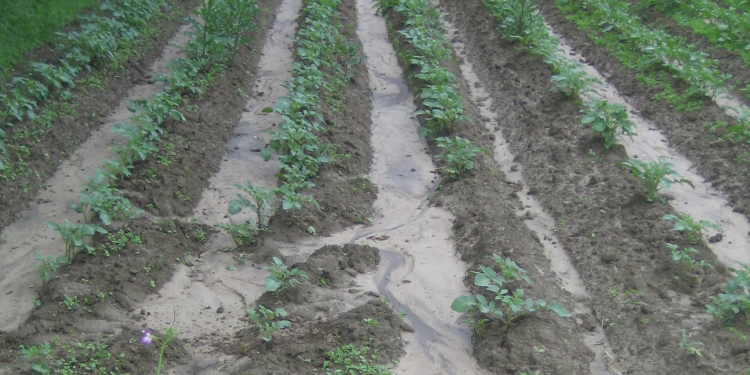Field Fodder: Think of crop residue as an airbag for your soil.
Soil health is something we hear a lot about these days. Cover crops, soil health tests, diversity in crop rotations and reduced compaction are all ways to improve soil health. However, there is some low-hanging fruit that farmers may be missing.
Minimizing soil erosion from water is a way to improve soil health that does not require a large investment in equipment, time and seed. Water erosion damages soil health in two ways. First and most obvious is by thinning the A horizon, or topsoil, and exposing the less productive subsoil. Second, and possibly the most destructive, is by raindrop impact and running water sorting soil components and degrading the soil by leaving behind less productive components.

Water soil erosion
Water erosion is a multiple-step process that starts with rain impacting bare soil. Raindrops hit with the force of a small bomb exploding, and such force can destroy soil structure at the surface. Soil is thrown into the air, and when the soil particles fall back to earth, the particles are suspended in water. Sand, silt, clay and organic matter are separated from one another in the moving water.
The heavier sand settles out of the soil water solution sooner than the lighter clay and organic matter. As silt particles settle out, they fill pores at the soil surface and form a crust, reducing the ability of the soil to absorb water.
Clay and organic matter are the lightest weight of the soil particles and are carried the farthest, often leaving the field and entering surface water. Clay and organic matter have a negative charge associated with them, and the negative charge holds soil nutrients for plants to use for growth and development. Loss of clay and organic matter reduces the ability of the soil to supply nutrients to plants.
Even small changes in the percentage of sand, silt, clay and organic matter can impact soil productivity. Sand settling out on the field can bury more productive soils and reduce crop productivity.
Crop residue left on the soil surface acts as a cushion against raindrop splash. Think of crop residue as an airbag for your soil. An airbag will keep you from impacting your vehicle’s steering wheel or dashboard in an accident. Crop residue will keep the raindrop bomb from exploding on the surface of bare soil.
Management of crop residue that leaves the soil surface covered is one of the best ways to improve soil health, whether or not you use cover crops. Tillage that buries residue reduces the impact of cover crops and slows or eliminates any soil health improvement you are trying to accomplish by planting cover crops. Reducing erosion is the first step to improving soil health.
Potato cultivation with improved protection against erosion
Compared to other agricultural crops, the cultivation of potatoes requires a particularly high level of protection against soil erosion. The most serious risk of soil erosion occurs during heavy rainfall on slopes and especially during the period when the potato has not reached the state of complete canopy establishment (a closed “haulm-shelter” covering the ridges). Heavy rainfall may lead to water accumulation between the ridges, so that even on slopes of less than 2 % water can drain off and cause soil displacements. As a result, fertile soil as well as fertilisers and pesticides are washed away from the field and deposited into other ecosystems.

In the event of soil erosion, the potatoes are partially exposed to sunrays which than lead to a green surface of the tubers so that they cannot be marketed. In extreme cases, when entire ridges are rinsed away, the emergence of the potatoes is completely prevented at these areas. In the course of vegetation, this leads to difficult cultivation of the (weedy) culture and a reduction in yield.
The Solution: Protection against erosion when using the dyking system called TerraProtect
The patent pending system TerraProtect, consists of one loosening tine with integrated stone protection and a subsequent small dyking device, which works between the ridges. It can either be used in combination with a potato planter or with ridging tillers. The loosening tine loosens the underground and thus increases the capacity of water absorption of the soil. The dyking-share, adapted to the contour of the ridges, generates traverse-dams (so-called dykes) for water storage. Various setting possibilities are available for a perfect adaptation to the specific soil conditions. This protects the productive soil and ensures an even water supply for the crop.

TerraProtect is available in two versions. In the basic version, TerraProtect is operated directly via double acting hydraulic control box of the tractor. The desired spacing of the dykes is simply set by an adjustable valve on the machine. The creation of spraying tracks is possible by manually switching off certain rows.
The TerraProtect Pro connects with an intelligent control for comfortable operation from the tractors cab. The maximum protection against soil erosion is achieved by an even spacing of the dykes, so an equal amount of water can be stored everywhere. This is made possible by an automatic control system that adapts the frequency of dyking to variable driving speeds. The TerraProtect Pro offers convenient single ridge switching for each dyker and an integrated spraying track switch-off for increased comfort.
The different versions of the TerraProtect system are now available for different machines of spring technology.









